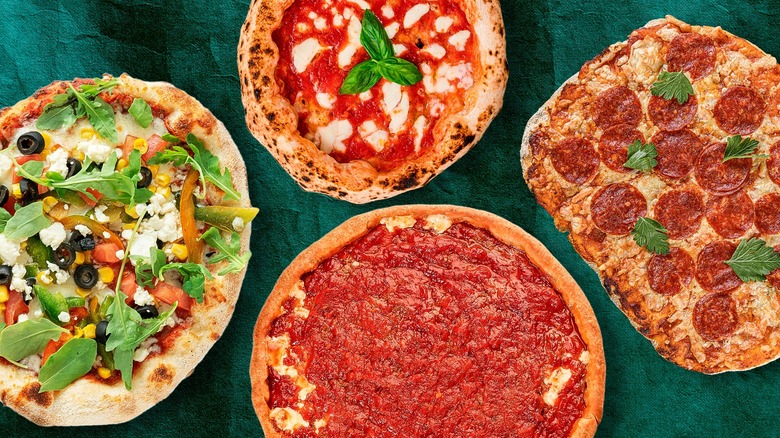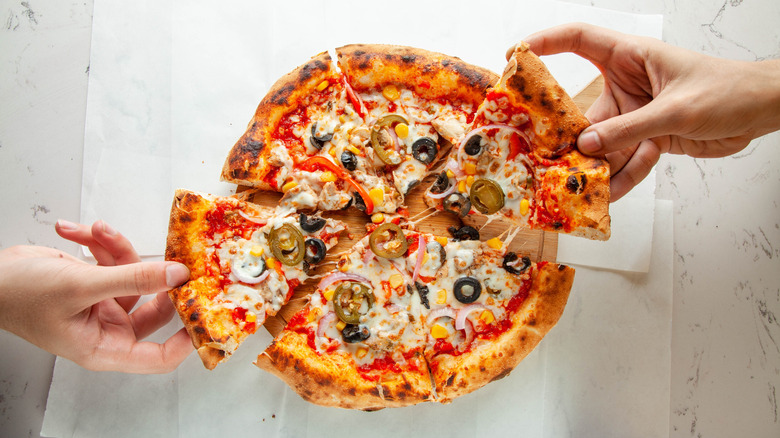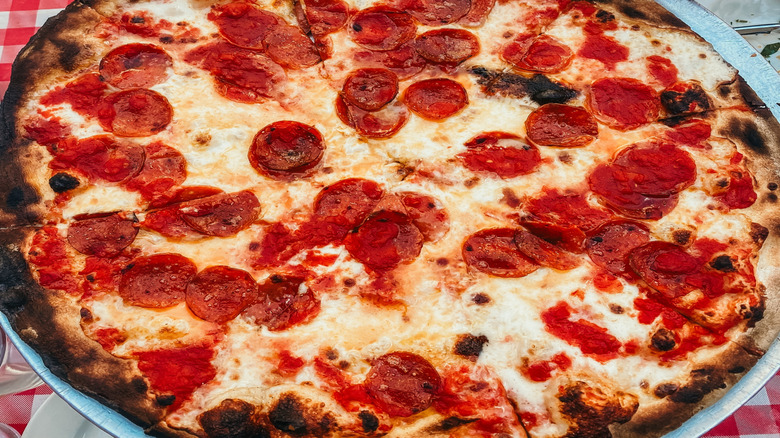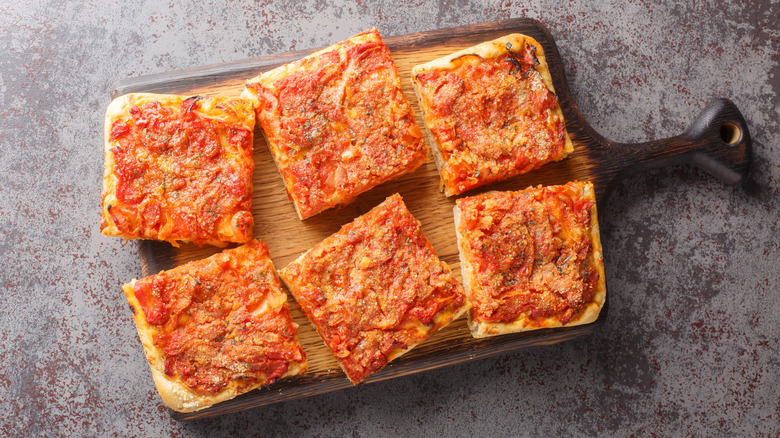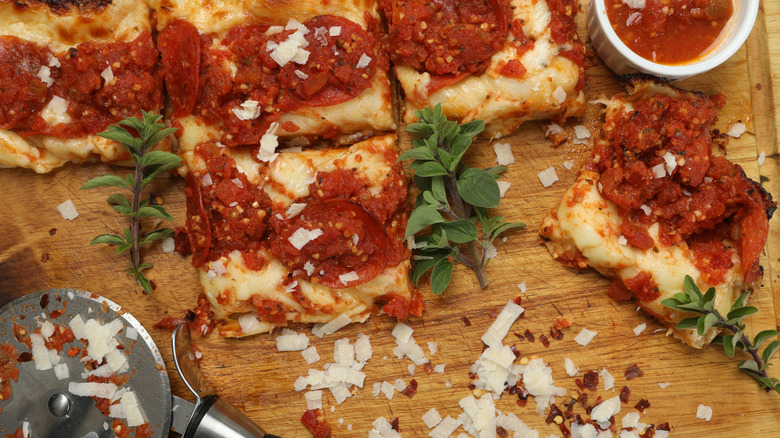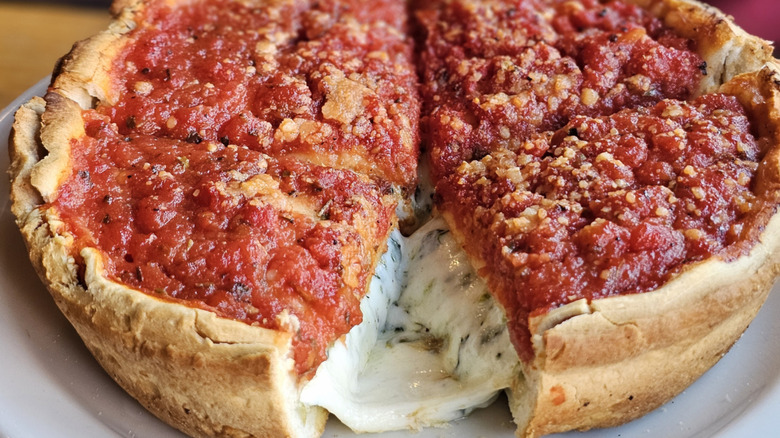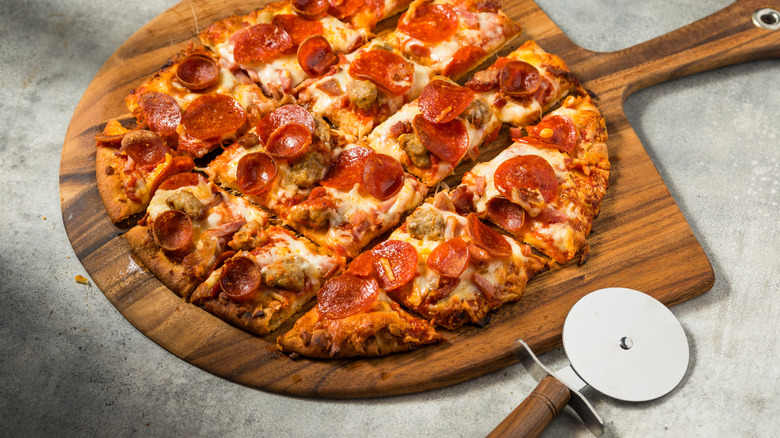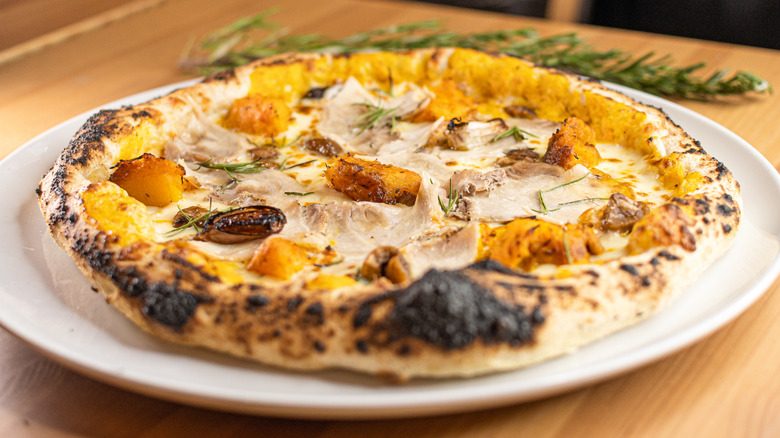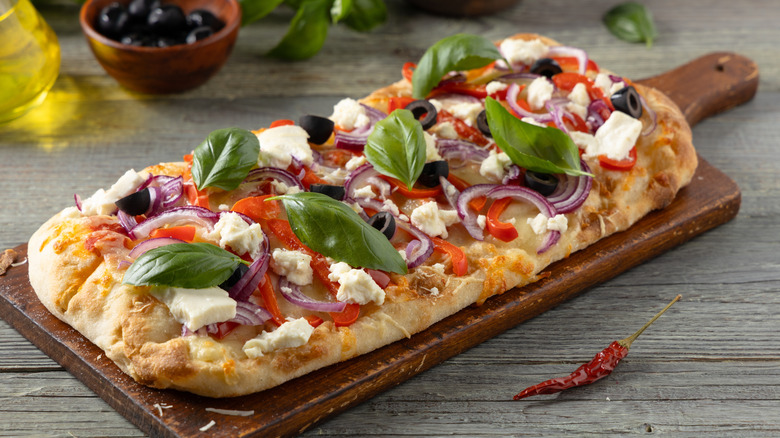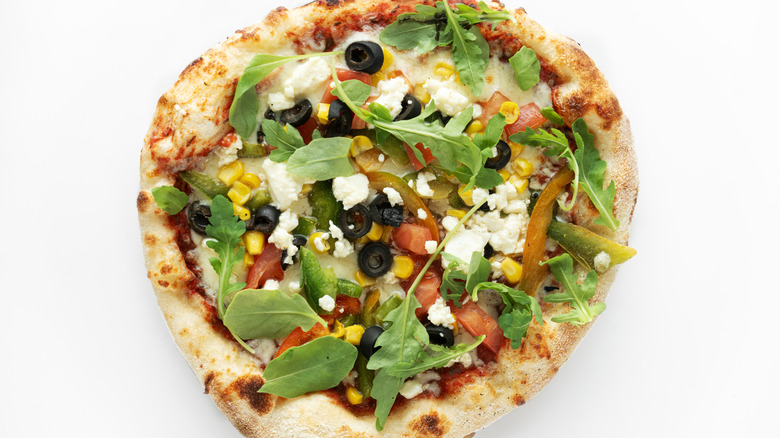10 Different Types Of Pizza And How They're Made
We may receive a commission on purchases made from links.
The average pizza delivery menu offers a number of different styles: hand-tossed, pan pizza, New York style, cracker crust, and so on. When you go to a restaurant, however, it's a whole new world ... and we can definitely agree that restaurant pizza is better than delivery. But how do you replicate those nuances at home, especially when there are so many types to choose from?
There are a few issues here. First, there's the fact that some pizza styles just sound too fancy to make yourself: Sicilian, New York style, Roman, Neapolitan ... how is a regular person supposed to concoct such delicacies? And then there's the fact that good old 'za is just downright confusing, with different styles boasting overlapping traits. That's because pizza is a bit of a minefield, says Blaine Parker, author and creator of Free the Pizza: "A lot of myth and emotion are tied up in this subject. We're talking a madness and mashup of evolution, purpose, intent, regionalism, and mythology." Breaking it down to its foundations, Scott Wiener of Scott's Pizza Tours in New York City says: "Pizza isn't a recipe, it's a format. So the only truly essential elements of the dish are that it's a yeasted dough that's stretched, topped, and baked."
That said, it's important to understand those differences in order to replicate them with as much fidelity as possible given the constraints of the home kitchen. On the assumption that there is at least some method to the madness, I sat down with the pizza experts to find out what's what.
1. Neapolitan
Naples is usually cited as the birthplace of pizza. Neapolitan immigrants carried their love of saucy, cheesy bread to new destinations and adapted it to the local equipment and ingredients. "Most of what we all generally recognize as 'pizza' is an evolution of the original thin, round, Neapolitan product," agrees Blaine Parker. "Chauvinists will claim it's the only true pizza." It is, at the very least, highly regulated, with the Associazione Verace Pizza Napoletana specifying the ingredients, preparation style, method of cooking, and more.
As such, it's not that easy to make. "Hot ovens bake these pies in one to two minutes to produce a soft, pliant base topped sparingly with simple ingredients," explains Wiener. With a puffy, charred edge, "This is a great pie to eat within seconds of it emerging from the oven. It's so simple and elegant, but the hardest style to nail." One of the reasons is that it's typically baked at 800 to 900 F, which you can only replicate at home with a pizza oven. Fortunately, these are much more affordable and compact than they used to be, so you might want to purchase one if you're a true pizza nerd.
When making Neapolitan pizza, use toppings that don't need a lot of cooking. If you're going to use heartier ingredients, such as bell peppers or onions, know that they are among the pizza toppings that need precooking and act accordingly.
2. New York style
"All the most famous pizzas were products of time and place," Scott Wiener says, and New York style is no different. In fact, after Neapolitan, it may be the type most associated with its birthplace. "New York pizza is a kind of reference standard, and was heavily influenced by an Italian immigrant and entrepreneur named Frank Mastro who sold used restaurant equipment," Blaine Parker explains. "He decided pizza would be a great business model for Italian immigrant families." With that in mind, he started tinkering with ovens and recipes in order to make them accessible to immigrant families, helping them get their start. "He may have done more for the popularity of pizza in the United States than anybody."
In general, explains Wiener, New York style pizzas are between 18 and 22 inches, cut into eight wedges. The pizza has a thin center, a slightly puffed rim, a crisp exterior, and a soft interior. "I love the ease of use for this style; I can grab a quick slice and be on my way. Perfect for someone on the move ... like New Yorkers!"
Mr. Mastro would doubtless be delighted to know that as long as you follow the right tips for making New York style pizza, you can get a pretty good result at home. Cooked at no higher than 700 F, according to Michael McCoy, founder of Prepa Pizza, you can make them in your home oven. Typically, a home oven will reach 550 F at the highest, but even at that you'll still get good NY style results. Although there are plenty of underrated pizza toppings you could put on your NY slice, most people associate it with plain cheese, or perhaps pepperoni or sausage.
3. Sicilian
If you haven't yet familiarized yourself with Sicilian pizza, then you should. For one thing, it's also known as "The Grandma," says Michael McCoy. For another, it's not the most inaccessible to make yourself, since it doesn't require the blasting temperatures of a wood-fired oven. Cooked in a square pan with crunchy edges around the crust and cut into squares, it has potential for a home-cooked group meal. According to Blaine Parker, it "is probably an Americanized evolution of a Sicilian bread called sfincione," a hearty cross between pizza and bread.
Personally, because I am lazy, too cheap to buy a professional pizza stone, and like a super-crunchy pizza bottom, I began making my pizzas on a nonstick cookie sheet long ago. My version isn't quite Sicilian, though, which requires proofing in the pan before topping and baking, a step I've been missing (but will now be trying). The danger with a thicker crust, though, is that you might have an undercooked or gummy layer. That's why, Scott Wiener says, "Some pizzerias par-bake the crust to prevent undercooked dough and to streamline ticket times during service. It's hard to make this one well, but the best ones are extremely satisfying."
If you're going to make this kind of pizza, make sure to get a nice pizza cutter, because using a knife to hack through a crunchy bottom is annoying with a capital A. And if you don't think you'll be making your own Sicilian pizza any time soon, that's okay: You can always buy a frozen pie online.
4. Detroit deep dish
In Michael McCoy's opinion, there are really only two types of pizza: hand-stretched and pan-baked. His only question: "Are they cooked on the deck or in a pan?" In the case of Detroit deep dish, the answer is a pan, and it makes a big difference to the final result. Indeed, pan pizza is A Whole Thing; you can buy entire cookbooks dedicated to it.
"Detroit pan pizza has lately emerged as a popular specialty pizza," Blaine Parker says. "The thick, rectangular, Detroit-style pizza was developed by a Michigan tavern owner who apparently took ideas from his Sicilian mother-in-law." Like the Sicilian pie, "It's more like a sfincione, with a thicker crust and baked in an oiled pan." There are other theories about where it could have come from, though. Michael McCoy describes it as a sister to the Sicilian that "came to pass when factory workers in Detroit used their car-part-holding steel pans to cook pizza."
Whatever the case, we have the Motor City to thank for puffy proofing and a caramelized cheesy edge, often made from Wisconsin Brick cheese and torched to perfection. The classic "racing stripes" of sauce are another dead giveaway that you're dealing with a Detroit style pizza. Plus, Scott Wiener says, "This is one of the easiest styles to make and withstands intense topping quantities." Although many people don't even know it exists, Detroit style is arguably one of the most delicious varieties. "When I make Detroit-style pizzas, I find that people are surprised at how much they love it," Parker adds.
5. Chicago deep dish
"Is there a more controversial style of pizza?" muses Blaine Parker. Perhaps not, since pizza geeks love to disagree about what exactly makes a Chicago deep dish pizza, arguing about depth and ratio and other mathematical terms that the rest of us are desperately trying to avoid when stuffing our faces with fat-slathered carbs. But answering such questions is important.
"Cooked in a pan lined with oil, the dough is a fairly low-hydration with a lot of oil in it," explains Jonathan Porter, founder of Chicago Pizza Tours. "Sliced cheese goes on after the dough, then toppings and a California tomato sauce on top." There shouldn't be anything other than tomatoes and salt in the sauce, and it has to go on top — a noticeable difference from most other pizzas. The sauce can be chunky or smooth, but it has to be on top. This is not the same as stuffed pizza, he cautions, which has sauce and toppings in the middle with an extra layer of dough on top.
Parker describes it as "A hearty, deep-dish pie, often made with a cornmeal crust and often loaded with good Chicago sausage. This is the pizza where one slice is a meal." But it's easy to mess up: "Balancing the ratios of crust, fillings, and toppings makes the difference between a killer pizza and a cheese-laden doorstop," he says. It's also not one to rush, as Scott Wiener says that it takes 30 to 40 minutes to bake. "This is a sit-down pizza," he says, "so the seat needs to be comfortable."
6. Chicago tavern style
You might know it as thin crust, but it's now called tavern style. There's a reason for that: "Tavern pizza originally utilized the same dough recipes as Chicago pan pizza," Michael McCoy explains. Pie purveyors would roll out thin crusts and top them, then hand out pieces for free "to keep guests drinking and happy." With easy-to-hold square slices, you can see why it makes great bar food.
Oddly, Chicago tavern style is actually a circular pizza, even though it's cut into squares. "It was developed around WWII," Jonathan Porter says, "when you had enough returning GIs that had a taste of pizza in Italy and were now asking their local tavern to make it. These tavern owners had never heard of or seen a pizza before, but baked these flatbread type pies and would chop them into squares because they had no plates or silverware." Amusingly he notes, "They never even got the idea to sell them until people started asking for them to go."
The "tavern style" appellation is relatively new, though. "We never called it that growing up," Porter adds, "but as more and more styles of pizza made their way to Chicago, we started to use tavern style to describe the Chicago thin crust." Where deep dish is for special occasions or visitors, tavern style is everyday goodness. The dough uses a Midwest flour like ceresota, he explains, which is then run through a sheeter at least three times to ensure a thin base. Add a thin, sweet or spicy, well-seasoned sauce and some part-skim mozzarella to ensure it burns a little, et voilà: You've got a yummy treat.
7. California
Sometimes you're in the mood to open the freezer and crack a frozen pizza in half (hey, this hack works). Other times, you want something a little more gourmet, and California pizza does the trick. "California pizza is the chef-driven product that doesn't care what you think," Blaine Parker says. "It's all about the toppings, and the crust takes a back seat." The style is associated with various well-known names: Alice Waters at Chez Panisse, Wolfgang Puck, and California Pizza Kitchen. This "cheffy" heritage, Parker says, is why the style is sometimes more about fanciness than good flavor, but that doesn't have to be the case.
Made right, California style pizza should have a wood-fired crust that is "blistered, bubbled, crispy, tender, tangy, and sweet." Parker describes combos such as burrata and squash blossoms as nothing short of a revelation. This might be a good pizza style with which to pair pickles. Yep, the tangy and acidic trend has been hitting the interwebz recently, especially in Southern California and the Southwest, so give it a try if that's your thing.
Some experts think that California pizza is simply one made with adventurous, fresh, and local toppings. If that sounds pretty good to you, then you might want to look up a recipe online, which will help you get the crust right, then pair it with whatever looks good at the farmers market or in the grocery store. Remember, though, if you're trying to replicate the wood-fired effect, you will likely need to snag yourself a specialty pizza oven.
8. Roman
Never heard of Roman pizza? Neither had I until beginning research on the most popular pizza styles. "The highest hydration of recipes, this larger-than-life pizza is the original slice shop pizza," Michael McCoy says. "It's served in the most famous shops with exotic toppings, fit for any handheld fine dining experience." It can be made both in the pan or cooked directly in the oven, he adds, depending on preference.
"There are several Roman styles," Scott Wiener agrees. "Pizza Tonda Romana is thin and round, like a flattened version of Neapolitan that bakes longer at a lower temp." This one is usually reserved for sit-down dining. "Then there's Pizza al Taglio, a rectangular pizza baked in pans and sold by the slice, often topped after the bake. Both are crispy, but I far prefer al Taglio."
As for its defining characteristics, Roman pizza has a tender, fluffy, medium-thick crust, similar to focaccia, Blaine Parker explains. Like California pizza, toppings can run in the fancy, look-at-me direction, but that's not necessarily a bad thing. When you're buying it from a bakery case, he adds, "the toppings are typically removed for reheating and are reapplied before serving." If you're going to make it at home, know that it's one of the more challenging styles, and Parker says that it "requires a commitment from the pizza maker."
9. Greek
If you haven't ever tried it, you might not know how good Greek pizza is. True, it's not the most popular type, though it is becoming better known. "The Greek pizza I know is a regional style ostensibly invented at Pizza House in New London, Connecticut, in the 1950s," explains Blaine Parker. "Instead of stretching dough to order, Costas 'Charlie' Kitsatis would stretch the dough for the day into 10-inch pans, which were ready to top and bake." The result is rather like a thin-crust focaccia, with an oily bottom, an oregano-forward sauce, and a blend of cheeses, often mozzarella and white cheddar. With lots of crunch and flavor, you won't walk away from Greek pizza dissatisfied.
"Greeks love adding their own holy trinity of feta, tomato, and pepperoncini," Michael McCoy notes, so you might want to try that classic combo if you're making it at home. You can make a handy Greek pizza in a 450 F oven, so this is totally accessible to the "servantless American cook" (we will always be indebted to you for that, Julia Child). The lower heat helps cook both the thicker crust and toppings well.
One of the biggest pizza mistakes you can make is using pre-shredded mozzarella or cheddar. Greek pizza (like all pizza) is all about a flavorful crust and ooey-gooey toppings, so you want the best possible cheese, unadulterated by anticaking agents that come with the pre-shred variety. Instead, stick a block in the freezer for 15 minutes if you want it to firm up before grating.
10. Cracker crust
Some pizza makers deny that cracker crust pizza even exists. One responded, "I don't know what you're talking about here." Fair enough, because some of my friends haven't heard of it either, but I grew up eating it at local pizza joints in Portland, Oregon, so I think of it as run-of-the-mill.
"There are various famous styles," Blaine Parker says, "ranging from Boston South Shore cracker crust, to un-yeasted St. Louis cracker crust, to traditional Roman-style cracker crust, to Chicago Tavern-style cracker crust to (get ready!) matzah or matzo pizza." If you guessed this one is made for Jewish people so they can gorge on pizza during Passover, you are correct. Personally, I don't think there's anything lovelier than a nice goat cheese on a pizza, and a cracker crust is particularly tasty with chevre, because you're kind of simulating the effect of a nice hors d'oeuvres plate.
It's a testament to pizza's huge impact on American and global culture that we haven't even been able to touch every style in this deep dive, and that new types are gaining influence all the time. For instance, New Haven style hails from Connecticut and is "an even more structured and charred pizza than its New York cousin," Blaine Parker says. Other styles — such as Windsor, Colorado, or St. Louis — can be found online, but you likely won't see them offered at your nearby pizza joint unless you live in the place of origin. That's what travel is for, right?
